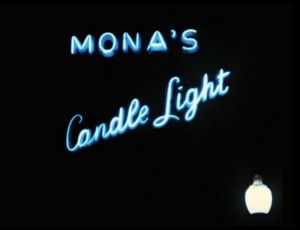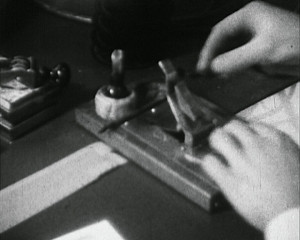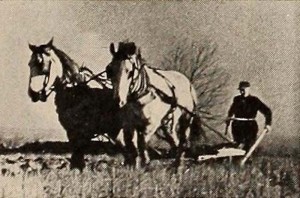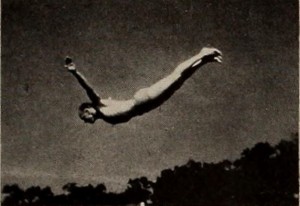"doc. pubblicitario"/advertising documentary
"Il film è un documentario di propaganda e vuole sopratutto essere un invito verso l’aeromodellismo. Il modello volante è oggi progettato su basi scientifiche e costruito con criteri tecnici in perfetta analogia col velivolo moderno. Il film s’inizia con una rapida rassegna dei più rudimentali velivoli coniati dalla fantasia del bambino, dall’aeroplano di carta all’aquilone, sino al giocattolo. Qui s’inizia la sequenza della scuola degli aeromodellisti e la costruzione completa di un modello a struttura reticolare con motore a fili elastici. Sul campo di volo il modello riceve il battesimo dell’aria col suo primo volo, mentre, a contrasto con le rabbiose evoluzioni dei modelli a motore, i modelli veleggiatori lanciati con cavo volteggiano leggeri e sicuri. La più alta perfezione costruttiva e la maggior finezza aerodinamica caratterizzano i grandi modelli di alianti per lancio dal pendio, che sono argomento della terza parte del film. Spontaneo è il passaggio ideale e logico dai modelli alianti al volo veleggiato, palestra di addestramento dei giovani per i futuri ardimenti dei cacciatori e bombardieri dell’aria."
"The film is a propaganda documentary and above all wants to be an invitation to model aircraft hobbyism. The model airplane is today designed on a scientific basis and built with technical criteria in perfect analogy with the modern aircraft. The film begins with a quick review of the most rudimentary aircraft coined by the child's imagination, from the paper plane to the kite, to the toy. Here begins the sequence of the model aircraft school and the complete construction of a reticular structure model with an elastic line motor. On the airfield, the model receives the baptism of the air with its first flight, while, in contrast to the furious evolutions of the motorized models, the sailplane models launched with cable fly light and safe. The highest constructive perfection and the greatest aerodynamic finesse make the large models of gliders, which are the subject of the third part of the film, suitable for launch from the slope. Spontaneous is the ideal and logical transition from glider models to soaring flight, a training ground for young people for the future feats of hunters and air bombers."—LITTORIALI DEL CINEMA ANNO XVIII program
"...che illustra il procedimento della costruzione in laboratorio dei modelli volanti, ponendo a raffronto il breve volo dei piccoli modelli con quello delle moderne pesanti macchine aeree"—I Littoriali del cinema: Un’altra interessante serie di documentari, La Stampa, September 3, 1939
"...which illustrates the process of laboratory construction of flying models, comparing the short flight of small models with that of modern heavy aerial machines."
"doc. didattico"/educational film

"This all-too-brief film, discovered at a flea market, depicts patrons of a lesbian bar (probably in San Francisco circa 1950) and performances by drag king Jimmy Reynard and singer Jan Jensen, singing American standards, including “I’ll Remember April” and “Tenderly.” A deceptively simple document, it presents exceedingly rare images of queer life on its own turf, and on its own terms, before gay liberation." UCLA Film & Television Archive.
"'Moods of Nature' by Paul Brunford, recently won a prize in the Institute of Amateur Cinematographers' contest in England. Not only does Brunford show a fine sense of rhythm, but a keen eye for composition and a splendid sense of cutting and dramatic values in nature. This picture merely deals with a storm arising and then subsiding. Brunford uses both water and earth to show this. The smashing waves, bending trees and waving wheatfields combine to create his drama. His photography however, is something for which he is to be especially congratulated." American Cinematographer, Jan. 1936, 24.

"A film featuring the staff, equipment, and key activities involved in the process of developing and printing Selo film at a laboratory. The viewer is guided through the different stages of the process with a step-by-step visual demonstration by Selo staff, accompanied by intertitles, providing information, and separating the scenes. The entire administrative and technical process is recorded, from the moment the used film stock arrives at the factory, continuing with the preparations made in the darkroom, before the chemical processes of developing, fixing, and washing takes place in the laboratory. The specific tasks of drying and measuring using industry-standard equipment, operated by hand, are next. In the printing laboratory, the negative is inspected and a Schustek 16mm printer is used. Intertitles explain the technical process of adjusting the light intensity when printing the film. In the spooling room, the printed positives are examined, and leader is cement spliced to the film. Title cards are produced. The completed film is projected and viewed. Each developed positive and negative film is skillfully wrapped, placed in a film can, packaged together into a Selo box and sealed, ready to be dispatched to the customer. A shot of many Selo Film boxes showing address labels completes the film" (EAFA Database).

"Charles A. Ferrie, jr., an urban movie maker, has gone back to the land for the beauty and charm of Mother Earth. Here, in carefully filtered and unfailingly well composed shots, he has caught the moist freshness of newly turned soil, the delicate loveliness of waving grain, the quiet dignity of men going about the homely tasks of the farm. His method of subject matter treatment has been to study these things from the outside, as a sensitive spectator, rather than to involve them (and the spectator) in a story told against such backgrounds. Mr. Ferrie's photography is consistently good and often striking, while his sequencing adds much of interest and inspiration to an essentially pastoral subject." Movie Makers, Dec. 1938, 620.

"Henry E. Hird, whose suavity and expertness as a movie maker increase each year, has chosen in his present offering to illustrate one of the cine film's most interesting capacities — its power to analyze motion. Introducing his footage with a lead title assembly finely accomplished with double exposure on moving backgrounds, Mr. Hird has observed and recorded with cinematic sureness such things as what happens when cream is poured into a cup of coffee and is filmed in such manner that the action is greatly slowed down for careful analysis. We watch the mechanics of flying seagulls, in landings and takeoffs. We look at the manner in which crystals are formed from chemical combinations, as well as at opening flowers, by time lapse filming. Smoke rings are shown and there are fine examples of the familiar dives caught in slow motion. Mr. Hird's picture compares favorably with the best slow motion studies of the professional screen, and it presents a number of fresh subjects." Movie Makers, Dec. 1946, 471, 486.
"dis. an. didattici"/animated educational doc.
"In Mount Vernon Seminary, the T. W. Willard Motion Picture Company has made a remarkable Kodachrome publicity picture. No interior was too large for their color work, as is clearly shown by the fine shots of a "prom." Large rooms with groups of girls taken by artificial light were rendered in true colors with striking effect. The film demonstrates quite clearly how successfully color can be used in industrial and publicity filming and that no special limitations are involved. The most attractive titles were double exposed on well chosen bits of school scenery. The film has an air of friendliness and polish that is entirely in keeping with the spirit of the school it portrays. Just enough of the right things are shown to make a favorable impression on prospective patrons of the school." Movie Makers, Dec. 1936, 548.
Total Pages: 79